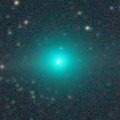
|
It passed near by the earth in late February, and it reached up to 4.9 mag (Feb. 23, Juan Jose Gonzalez). The coma extended up to 20 arcmin, and the anti-tail was clearly visible. Now it is fading rapidly. It has already faded down to 8.1 mag (Mar. 27, Marco Goiato). Because moving along the retrograde orbit, it will be lower rapidly in the evening sky. It will be too low to observe at 12 mag in late May.
Date(TT) R.A. (2000) Decl. Delta r Elong. m1 Best Time(A, h)
Mar. 28 6 51.34 22 10.2 1.267 1.674 94 8.5 19:24 (165, 31)
Apr. 4 6 42.38 22 19.1 1.509 1.744 85 9.1 19:14 (158, 29)
|

|
Brightening very rapidly, faster than expected. It is already so bright as 9.2 mag (Mar. 22, Juan Jose Gonzalez). It is expected to reach to 8 mag in 2009 summer. Although it had been low for a while, it is getting higher after this, and it will be observable at 8-10 mag in good condition for a long time until late autumn.
Date(TT) R.A. (2000) Decl. Delta r Elong. m1 Best Time(A, h)
Mar. 28 22 44.15 33 59.1 3.987 3.275 39 9.5 4:45 (239,-15)
Apr. 4 22 46.85 33 57.0 3.949 3.256 40 9.5 4:51 (235,-10)
|

|
New bright comet. It seems to be brightening very rapidly. Now it is so bright as 8.2 mag (Mar. 26, Juan Jose Gonzalez). Now it locates very low in the evening, and it will be not observable in April. But in the Northern Hemisphere, it will appear in the morning sky at 11 mag in early May, then it keeps observable in good condition while fading. In the Southern Hemisphere, it had been locating in good position until discovered in mid March, however, now it is not observable. It will appear in the morning sky in late May when it fades down to 12.5 mag.
Date(TT) R.A. (2000) Decl. Delta r Elong. m1 Best Time(A, h)
Mar. 28 2 15.10 21 27.8 1.211 0.646 32 10.0 19:24 (112, -7)
Apr. 4 1 57.38 25 26.7 1.336 0.606 25 10.0 19:14 (110,-16)
|

|
Now it is 10.8 mag, already so bright (Mar. 22, Juan Jose Gonzalez). It will be bright at 9-10 mag for a long time from spring to autumn.
Date(TT) R.A. (2000) Decl. Delta r Elong. m1 Best Time(A, h)
Mar. 28 19 4.45 -18 25.6 1.500 1.683 82 10.9 4:45 (245, 59)
Apr. 4 19 24.10 -17 55.3 1.429 1.660 84 10.7 4:51 (240, 61)
|
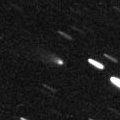
|
Brightening very rapidly, faster than expected. Now it is bright as 9.3 mag (Mar. 26, Juan Jose Gonzalez), already visible visually. It keeps 10-11 mag and observable in the evening sky for a long time until May.
Date(TT) R.A. (2000) Decl. Delta r Elong. m1 Best Time(A, h)
Mar. 28 3 20.27 21 36.0 1.766 1.292 46 10.9 19:24 (121, 5)
Apr. 4 3 47.63 23 32.8 1.802 1.317 45 10.9 19:14 (124, 6)
|

|
It brightened much faster than expected, and reached up to 8.4 mag (Jan. 30, Juan Jose Gonzalez). It was very large and visible through binoculars. It will be fading after this, but still bright as 9.3 mag (Mar. 26, Juan Jose Gonzalez). It keeps locating high in the evening sky for a while. It keeps higher than 40 degree until mid May when it fades down to 14 mag.
Date(TT) R.A. (2000) Decl. Delta r Elong. m1 Best Time(A, h)
Mar. 28 6 57.70 17 6.4 1.129 1.589 96 11.1 19:24 (165, 37)
Apr. 4 7 17.64 16 42.8 1.203 1.623 94 11.5 19:14 (166, 37)
|
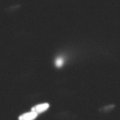
|
It was reported much brighter than predicted in late March, as 9.2 mag (Mar. 26, Juan Jose Gonzalez). It is expected to brighten up to 10 mag from late 2009 to early 2010. Good condition in the Southern Hemisphere. In the Northern Hemisphere, it is observable in the evening low sky from February to April. Then it becomes unobservable until September. But after October, it is observable at 10 mag for a while in good condition. In the Southern Hemisphere, it keeps observable for a long time while brightening until June when it brightens to 11 mag. But it becomes unobservable around and after the brightest time.
Date(TT) R.A. (2000) Decl. Delta r Elong. m1 Best Time(A, h)
Mar. 28 5 36.55 -29 41.4 3.114 3.110 80 11.7 19:24 ( 92, 62)
Apr. 4 5 43.67 -27 14.8 3.116 3.060 77 11.6 19:14 ( 95, 59)
|

|
It was reported much brighter than predicted in late March, as 9.5 mag (Mar. 26, Juan Jose Gonzalez). It will reach to 10-11 mag in June. In the Northern Hemisphere, it keeps observable in good condition until May when it becomes brightest. But it will never be observable again after that. In the Southern Hemisphere, it is not observable until April. But after that, it will be observable while fading gradually.
Date(TT) R.A. (2000) Decl. Delta r Elong. m1 Best Time(A, h)
Mar. 28 4 45.20 45 12.8 1.729 1.679 70 11.9 19:24 (150, 0)
Apr. 4 5 2.77 41 36.9 1.733 1.610 65 11.8 19:14 (148, 3)
|

|
It brightened up to 9.8 mag in December and January (Dec. 28, Juan Jose Gonzalez). Now it is fading, but still bright as 11.5 mag (Mar. 26, Juan Jose Gonzalez). It keeps visible visually for a long time until June when it becomes low in the evening at 13 mag.
Date(TT) R.A. (2000) Decl. Delta r Elong. m1 Best Time(A, h)
Mar. 28 6 34.86 36 30.8 3.040 3.198 89 12.0 19:24 (165, 17)
Apr. 4 6 42.67 35 18.2 3.179 3.245 84 12.2 19:14 (163, 17)
|

|
Now it is very bright as 11.5 mag (Mar. 26, Juan Jose Gonzalez). It keeps observable in good condition until May, then it keeps observable until July when it becomes too low in the evening sky, around 12-13 mag for a long time.
Date(TT) R.A. (2000) Decl. Delta r Elong. m1 Best Time(A, h)
Mar. 28 9 18.70 19 41.2 1.557 2.315 128 12.7 20:55 (180, 35)
Apr. 4 9 19.41 19 19.7 1.607 2.299 121 12.7 20:28 (180, 36)
|

|
It brightened up to 11.5 mag in summer (Aug. 4, Marco Goiato). Although it is not observable in the Northern Hemisphere, it keeps observable in good condition for a long time in the Southern Hemisphere. However, no visual observations have been reported since last summer. Recent CCD observations suggest that it is still visible visually around 12-13 mag.
Date(TT) R.A. (2000) Decl. Delta r Elong. m1 Best Time(A, h)
Mar. 28 2 54.97 -63 36.3 3.138 2.985 71 12.7 19:24 ( 33, 38)
Apr. 4 3 17.31 -60 52.6 3.170 3.018 72 12.8 19:14 ( 37, 39)
|
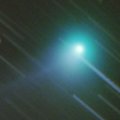
|
It reached to 6.3 mag in September in the southern sky (Sept. 4, Marco Goiato). Now it is fading, but still bright as 11.2 mag visually (Mar. 22, Juan Jose Gonzalez). It has already faded down to 15.0 mag by CCD observations (Mar. 11, Ken-ichi Kadota). It keeps observable in the northern sky while fading gradually. In the Southern Hemisphere, it will never be observable again.
Date(TT) R.A. (2000) Decl. Delta r Elong. m1 Best Time(A, h)
Mar. 28 21 50.68 59 26.4 3.111 2.820 64 13.2 4:45 (211,-21)
Apr. 4 22 7.18 62 6.0 3.193 2.900 64 13.5 4:51 (207,-21)
|

|
It reached to 10.9 mag in May (May 11, Marco Goiato). It is fading slowly. Now it is 13.7 mag (Mar. 22, Juan Jose Gonzalez), still visible visually. It keeps bright as 13-14 mag for a long time after this until summer.
Date(TT) R.A. (2000) Decl. Delta r Elong. m1 Best Time(A, h)
Mar. 28 16 50.30 24 50.3 3.381 3.845 110 13.7 4:29 (180, 30)
Apr. 4 16 50.37 26 45.7 3.376 3.891 114 13.7 4:01 (180, 28)
|

|
Since the major outburst in last September, with a new outburst in December, it has been so bright as 10-11 mag for about half a year. Now it is still bright as 11.5 mag (Mar. 26, Juan Jose Gonzalez).
Date(TT) R.A. (2000) Decl. Delta r Elong. m1 Best Time(A, h)
Mar. 28 7 40.20 23 20.1 5.773 6.116 105 13.7 19:24 (178, 32)
Apr. 4 7 40.95 23 11.6 5.884 6.118 98 13.7 19:14 (173, 32)
|
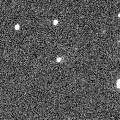
|
Now it is 13.2 mag and visible visually (Mar. 26, Juan Jose Gonzalez). It will brighten up to 12-13 mag in 2010 summer. In 2009, it keeps observable in good condition until summer.
Date(TT) R.A. (2000) Decl. Delta r Elong. m1 Best Time(A, h)
Mar. 28 12 16.08 13 31.7 2.149 3.119 163 14.4 23:51 (180, 41)
Apr. 4 12 10.70 13 52.4 2.148 3.097 157 14.4 23:18 (180, 41)
|

|
The condition of this return is bad, and it has not been observed yet. It will appear in the morning low sky at 13.5 mag in June. Then it will be getting higher gradually while fading slowly.
Date(TT) R.A. (2000) Decl. Delta r Elong. m1 Best Time(A, h)
Mar. 28 23 23.30 0 11.1 2.595 1.660 16 14.9 4:45 (272, -3)
Apr. 4 23 42.04 2 29.4 2.539 1.617 17 14.7 4:51 (268, -2)
|

|
Now it is 13.0 mag (Mar. 26, Juan Jose Gonzalez). It had been bright and visible visually around 13 mag from spring to autumn in 2008. It will be visible visually at 14 mag again until summer.
Date(TT) R.A. (2000) Decl. Delta r Elong. m1 Best Time(A, h)
Mar. 28 14 42.30 34 12.1 5.713 6.414 131 14.7 2:21 (180, 21)
Apr. 4 14 34.81 35 10.8 5.719 6.438 132 14.7 1:46 (180, 20)
|

|
Now it is visible visually at 13.8 mag (Mar. 21, Jose Carvajal). It will be observable at 15 mag in good condition in spring.
Date(TT) R.A. (2000) Decl. Delta r Elong. m1 Best Time(A, h)
Mar. 28 12 1.98 11 35.8 1.433 2.409 164 14.9 23:37 (180, 44)
Apr. 4 11 53.99 10 47.0 1.439 2.396 158 14.9 23:01 (180, 44)
|

|
No observations have been reported since last December. But now it should be already bright as 15 mag. It is expected to brighten up to 12.5 mag in May and June. The condition is good in the Southern Hemisphere, and it keeps observable for a long time until August. In the Northern Hemisphere, it is only observable from mid June to mid August in the evening low sky.
Date(TT) R.A. (2000) Decl. Delta r Elong. m1 Best Time(A, h)
Mar. 28 21 25.63 -47 53.2 2.338 2.107 64 15.3 4:45 (306, 41)
Apr. 4 21 24.46 -49 6.6 2.161 2.063 70 15.0 4:51 (307, 47)
|

|
It brightened up to 12.7 mag in 2008 spring (Apr. 12, Marco Goiato). But it faded down to 14.9 mag in July (July 22, Mitsunori Tsumura). No observations have been reported for a long time since last summer. But in the Southern Hemisphere, it has appeared in the morning sky, and it will be observable in good condition after this. It will never be observable again in the Northern Hemisphere.
Date(TT) R.A. (2000) Decl. Delta r Elong. m1 Best Time(A, h)
Mar. 28 19 39.68 -48 23.5 3.698 3.664 80 15.2 4:45 (307, 59)
Apr. 4 19 48.56 -48 55.8 3.651 3.702 85 15.2 4:51 (310, 63)
|
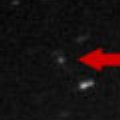
|
It had been observed until mid January in the evening low sky. It reached up to 14.1 mag (Jan. 11, Ken-ichi Kadota). Now it is not observable. It will be observable again in summer, but it will be fainter than 17 mag.
Date(TT) R.A. (2000) Decl. Delta r Elong. m1 Best Time(A, h)
Mar. 28 0 18.68 0 54.9 2.882 1.885 2 15.3 4:45 (280,-15)
Apr. 4 0 35.72 2 17.8 2.905 1.912 5 15.4 4:51 (276,-13)
|

|
Now it is 14.5 mag and visible visually (Mar. 22, Juan Jose Gonzalez). It will be observable at 15-16 mag in good condition until spring.
Date(TT) R.A. (2000) Decl. Delta r Elong. m1 Best Time(A, h)
Mar. 28 9 4.16 24 36.3 2.933 3.584 123 15.4 20:40 (180, 30)
Apr. 4 9 4.13 24 26.5 3.016 3.581 116 15.5 20:13 (180, 31)
|
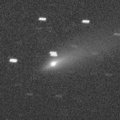
|
It reached up to 9.6 mag in summer (Aug. 2, Juan Jose Gonzalez). Now it is fading. But it is still reported very bright as 12.8 mag visually (Mar. 22, Juan Jose Gonzalez). But it has already faded down to 15.4 mag by CCD observations (Mar. 11, Ken-ichi Kadota). It keeps observable in good condition until June when it becomes fainter than 18 mag.
Date(TT) R.A. (2000) Decl. Delta r Elong. m1 Best Time(A, h)
Mar. 28 13 12.48 40 12.0 2.007 2.808 135 15.6 0:52 (180, 15)
Apr. 4 13 3.49 40 5.5 2.067 2.856 134 15.8 0:16 (180, 15)
|

|
It was expected to reach up to 7 mag and to be observable in good condition in winter. But finally, the comet has never been recovered after all. This comet has not been observed since 1986. It was not detected, fainter than 20 mag on Dec. 1 (Takaaki Oribe). So it will be much fainter than expected, maybe already disappeared.
Date(TT) R.A. (2000) Decl. Delta r Elong. m1 Best Time(A, h)
Mar. 28 5 28.35 26 25.4 1.734 1.773 75 16.1 19:24 (147, 20)
Apr. 4 5 49.11 26 20.6 1.854 1.837 73 16.9 19:14 (148, 21)
|

|
It keeps 16 mag until late April. But it locates low in the Northern Hemisphere.
Date(TT) R.A. (2000) Decl. Delta r Elong. m1 Best Time(A, h)
Mar. 28 15 5.69 -34 3.1 2.012 2.778 131 16.2 2:45 (180, 89)
Apr. 4 14 55.95 -31 11.4 1.969 2.820 141 16.2 2:08 (180, 86)
|

|
Now it is 17.0 mag (Mar. 18, Leonid Elenin). It will be brightening rapidly after this, and will be 10 mag in autumn. It keeps observable for a long time until 2010 February. But in the Northern Hemisphere, it will be lower than 20 degree after July when it becomes about 13 mag, then it keeps very low all through the brightest time. It locates a bit higher in the Southern Hemisphere.
Date(TT) R.A. (2000) Decl. Delta r Elong. m1 Best Time(A, h)
Mar. 28 13 8.37 -1 34.6 1.378 2.366 169 16.5 0:48 (180, 57)
Apr. 4 13 1.45 -0 55.8 1.323 2.321 174 16.2 0:13 (180, 56)
|
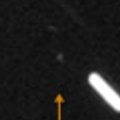
|
Brightened rapidly, and now it reached up to 16.2 mag (Mar. 10, Ken-ichi Kadota). It will be observable at 16.5 mag until April. It moves southwards very fast after early April, and will be unobservable very soon in the Northern Hemisphere.
Date(TT) R.A. (2000) Decl. Delta r Elong. m1 Best Time(A, h)
Mar. 28 20 3.89 53 6.4 0.281 0.956 73 16.3 4:45 (205, -6)
Apr. 4 20 34.68 42 16.1 0.266 0.931 67 16.5 4:51 (211, 3)
|

|
Now it is 14.7 mag and visible visually (Mar. 22, Juan Jose Gonzalez). It should have reached up to 14.5 mag in summer in the southern sky, but it is already fading. It keeps observable while the comet will be fading slowly after this.
Date(TT) R.A. (2000) Decl. Delta r Elong. m1 Best Time(A, h)
Mar. 28 11 29.32 -9 18.9 2.979 3.949 164 16.3 23:04 (180, 64)
Apr. 4 11 24.13 -7 11.7 3.056 4.001 158 16.4 22:32 (180, 62)
|
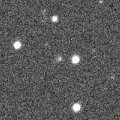
|
Although it had been low for a while, now it is getting higher. It will brighten up to 15 mag in 2009 and 2010, and will be observable for a long time in good condition.
Date(TT) R.A. (2000) Decl. Delta r Elong. m1 Best Time(A, h)
Mar. 28 21 45.64 26 19.5 3.965 3.338 45 16.7 4:45 (237, 0)
Apr. 4 21 46.90 28 7.3 3.864 3.300 49 16.6 4:51 (231, 4)
|

|
Now it is 16.8 mag (Feb. 21, Ken-ichi Kadota). It will be getting fainter and lower in the evening sky. It becomes unobservable in May.
Date(TT) R.A. (2000) Decl. Delta r Elong. m1 Best Time(A, h)
Mar. 28 4 13.17 27 4.5 2.712 2.361 59 16.6 19:24 (133, 10)
Apr. 4 4 27.67 27 15.1 2.784 2.365 55 16.7 19:14 (133, 9)
|
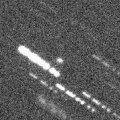
|
Now it is 16.4 mag (Mar. 14, Ken-ichi Kadota). It will be observable at 16.5 mag in good condition in 2009 spring.
Date(TT) R.A. (2000) Decl. Delta r Elong. m1 Best Time(A, h)
Mar. 28 16 46.41 33 16.4 2.611 3.085 109 16.7 4:25 (180, 22)
Apr. 4 16 30.61 34 35.2 2.550 3.105 114 16.7 3:42 (180, 20)
|

|
Peculiar asteroid moving along a cometary orbit. It will be observable around 17 mag in good condition for a long time until May. It will fade out very rapidly after May.
Date(TT) R.A. (2000) Decl. Delta r Elong. m1 Best Time(A, h)
Mar. 28 14 31.26 -3 43.7 1.173 2.092 148 16.9 2:10 (180, 59)
Apr. 4 14 24.73 -3 28.1 1.182 2.139 156 16.8 1:36 (180, 59)
|

|
It will reach to 17 mag at opposition in March. But then it will fade out soon, and will be fainter than 18 mag in May.
Date(TT) R.A. (2000) Decl. Delta r Elong. m1 Best Time(A, h)
Mar. 28 11 59.20 -7 10.0 1.600 2.592 171 17.0 23:34 (180, 62)
Apr. 4 11 55.22 -6 33.7 1.601 2.582 165 17.1 23:03 (180, 62)
|

|
It will reach to 17 mag in March. But it will fade out soon, and will be fainter than 18 mag in May.
Date(TT) R.A. (2000) Decl. Delta r Elong. m1 Best Time(A, h)
Mar. 28 11 17.60 -10 10.1 1.371 2.338 161 17.1 22:50 (180, 65)
Apr. 4 10 43.56 -7 40.5 1.439 2.347 147 17.2 21:49 (180, 63)
|

|
Now it is 17.4 mag (Feb. 21, Yasukazu Ikari). It will reach to 15 mag in 2010. It keeps observable for a long time after this in the Northern Hemisphere.
Date(TT) R.A. (2000) Decl. Delta r Elong. m1 Best Time(A, h)
Mar. 28 15 40.48 -2 28.7 5.540 6.248 131 17.2 3:19 (180, 58)
Apr. 4 15 39.05 -1 35.1 5.431 6.212 138 17.1 2:50 (180, 57)
|

|
Peculiar asteroid with a cometary orbit. It moves northwards very fast. It reaches up to 17 mag from late March to early April, however, it will fade out very soon.
Date(TT) R.A. (2000) Decl. Delta r Elong. m1 Best Time(A, h)
Mar. 28 9 57.05 -32 30.1 0.878 1.728 134 17.1 21:32 (180, 87)
Apr. 4 9 54.49 -21 20.8 0.905 1.755 134 17.2 21:03 (180, 76)
|
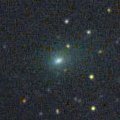
|
First return of a bright new periodic comet discovered by SOHO spacecraft in 2003. Now it was re-discovered by STEREO-B spacecraft. It reached up to 6-7 mag in the SOHO images in late December, then it was observed around 10 mag in the morning sky in early January. Now it is fading. It is still visible visually at 13.7 mag (Mar. 22, Juan Jose Gonzalez). But it has faded down to 15.4 mag on Mar. 1 by CCD observations (Ken-ichi Kadota). It keeps observable in good condition while fading gradually after this.
Date(TT) R.A. (2000) Decl. Delta r Elong. m1 Best Time(A, h)
Mar. 28 14 55.31 4 44.3 0.840 1.740 142 17.2 2:35 (180, 50)
Apr. 4 14 38.73 5 45.9 0.884 1.825 151 17.6 1:51 (180, 49)
|

|
Brightening rapidly than expected. It reached up to 16.8 mag (Feb. 17, Yasukazu Ikari). It will be fading after this, and will be fainter than 18 mag in April.
Date(TT) R.A. (2000) Decl. Delta r Elong. m1 Best Time(A, h)
Mar. 28 9 53.90 7 51.9 0.868 1.756 140 17.7 21:30 (180, 47)
Apr. 4 9 57.56 6 56.7 0.931 1.782 134 18.0 21:06 (180, 48)
|
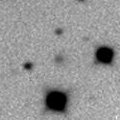
|
At the discovery in 2001, it became much brighter after the perihelion passage. In this apparition, although it was so faint as 20 mag in early September, it brightened very rapidly, and it reached up to 16.3 mag (Feb. 5, Ken-ichi Kadota). It keeps observable in good condition for a while after this. But it will fade out rapidly after this. It has already faded down to 17.6 mag (Feb. 21, Yasukazu Ikari). It will be fainter than 18 mag in April.
Date(TT) R.A. (2000) Decl. Delta r Elong. m1 Best Time(A, h)
Mar. 28 8 32.77 25 3.4 1.496 2.140 116 17.9 20:09 (180, 30)
Apr. 4 8 39.74 24 39.6 1.587 2.165 111 18.1 19:49 (180, 30)
|
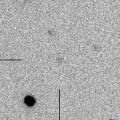
|
It was observed at 18 mag from autumn to winter in 2007. It will be observable again at 18 mag from winter to spring in 2009.
Date(TT) R.A. (2000) Decl. Delta r Elong. m1 Best Time(A, h)
Mar. 28 10 18.23 -5 24.4 4.788 5.658 147 17.9 21:54 (180, 60)
Apr. 4 10 16.46 -5 11.7 4.851 5.666 141 18.0 21:25 (180, 60)
|

|
Great outburst occured in 2007 October, and it bacame a naked eye comet of 2 mag. It kept so bright as 5.5 mag still in 2008 spring (Apr. 30, Carlos Labordena), but it was extremely faint and difficult to see. The size was so large, the diameter was larger than 60 arcmin. Now it became observable in good condition again. The extremely faint large diffuse glow may be detected with a best sky condition, around 5-6 mag with a diameter of 1 or 2 degrees. Mitsunori Tsumura detected a possible glow of Comet Holmes on Nov. 4. Current brightness of the central core is 17.7 mag (Feb. 13, Catalina Sky Survey), much brighter than pre-outburst brightness still now.
Date(TT) R.A. (2000) Decl. Delta r Elong. m1 Best Time(A, h)
Mar. 28 8 15.70 25 27.9 3.930 4.416 112 19.4 19:52 (180, 30)
Apr. 4 8 15.67 25 6.3 4.051 4.435 106 19.5 19:24 (180, 30)
|

|
It was observed bright at 16.5-17 mag from late 2006 to early 2007. However, it is fading after that, although it is getting closer to the sun. It was so faint as 19.4 mag around the perihelion passage in 2008 spring (Mar. 10, Mitsunori Tsumura). This comet was observed so faint around the perihelion passage in the previous apparition at the discovery. It faded out before the perihelion passage again in this apparition. No observations have been reported since 2008 April at all. At least, it is fainter than 20 mag now (Mar. 15, Leonid Elenin).
Date(TT) R.A. (2000) Decl. Delta r Elong. m1 Best Time(A, h)
Mar. 28 11 28.77 24 28.7 3.530 4.417 149 21.9 23:04 (180, 31)
Apr. 4 11 25.63 24 37.8 3.585 4.425 143 22.0 22:33 (180, 30)
|
|
![]()
 22P/Kopff
22P/Kopff 67P/Churyumov-Gerasimenko
67P/Churyumov-Gerasimenko 144P/Kushida
144P/Kushida C/2007 Q3 ( Siding Spring )
C/2007 Q3 ( Siding Spring ) C/2008 T2 ( Cardinal )
C/2008 T2 ( Cardinal ) C/2006 OF2 ( Broughton )
C/2006 OF2 ( Broughton ) 116P/Wild 4
116P/Wild 4 C/2007 G1 ( LINEAR )
C/2007 G1 ( LINEAR ) C/2008 A1 ( McNaught )
C/2008 A1 ( McNaught ) C/2006 Q1 ( McNaught )
C/2006 Q1 ( McNaught ) 29P/Schwassmann-Wachmann 1
29P/Schwassmann-Wachmann 1 65P/Gunn
65P/Gunn 64P/Swift-Gehrels
64P/Swift-Gehrels C/2005 L3 ( McNaught )
C/2005 L3 ( McNaught ) 77P/Longmore
77P/Longmore C/2008 Q3 ( Garradd )
C/2008 Q3 ( Garradd ) C/2007 B2 ( Skiff )
C/2007 B2 ( Skiff ) 68P/Klemola
68P/Klemola 74P/Smirnova-Chernykh
74P/Smirnova-Chernykh 19P/Borrelly
19P/Borrelly 85P/Boethin
85P/Boethin C/2009 F5 ( McNaught )
C/2009 F5 ( McNaught ) 88P/Howell
88P/Howell 209P/2008 X2 ( LINEAR )
209P/2008 X2 ( LINEAR ) C/2006 U6 ( Spacewatch )
C/2006 U6 ( Spacewatch ) C/2008 N1 ( Holmes )
C/2008 N1 ( Holmes ) 59P/Kearns-Kwee
59P/Kearns-Kwee C/2008 Q1 ( Maticic )
C/2008 Q1 ( Maticic ) 2001 TX16
2001 TX16 143P/Kowal-Mrkos
143P/Kowal-Mrkos C/2009 B2 ( LINEAR )
C/2009 B2 ( LINEAR ) C/2008 FK75 ( Lemmon-Siding Spring )
C/2008 FK75 ( Lemmon-Siding Spring ) 2009 FW23
2009 FW23 210P/2008 X4 ( Christensen )
210P/2008 X4 ( Christensen ) P/2008 Y2 ( Gibbs )
P/2008 Y2 ( Gibbs ) 204P/2008 R5 ( LINEAR-NEAT )
204P/2008 R5 ( LINEAR-NEAT ) C/2007 S2 ( Lemmon )
C/2007 S2 ( Lemmon ) 17P/Holmes
17P/Holmes 173P/2005 T1 ( Mueller 5 )
173P/2005 T1 ( Mueller 5 )![]()



























